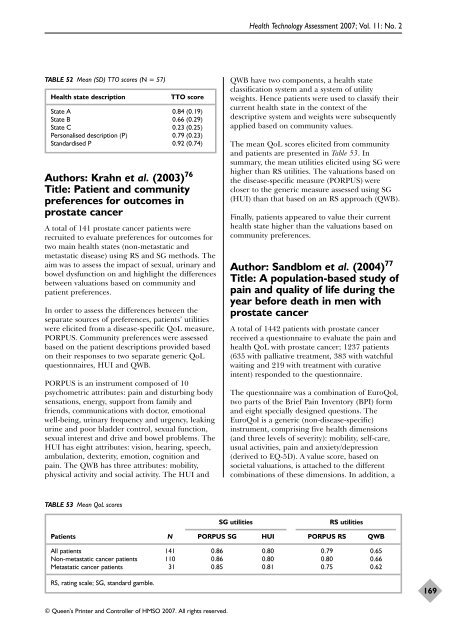Docetaxel with prednisone or prednisolone for the treatment of ...
Docetaxel with prednisone or prednisolone for the treatment of ...
Docetaxel with prednisone or prednisolone for the treatment of ...
Create successful ePaper yourself
Turn your PDF publications into a flip-book with our unique Google optimized e-Paper software.
TABLE 52 Mean (SD) TTO sc<strong>or</strong>es (N = 57)<br />
Health state description TTO sc<strong>or</strong>e<br />
State A 0.84 (0.19)<br />
State B 0.66 (0.29)<br />
State C 0.23 (0.25)<br />
Personalised description (P) 0.79 (0.23)<br />
Standardised P 0.92 (0.74)<br />
Auth<strong>or</strong>s: Krahn et al. (2003) 76<br />
Title: Patient and community<br />
preferences f<strong>or</strong> outcomes in<br />
prostate cancer<br />
A total <strong>of</strong> 141 prostate cancer patients were<br />
recruited to evaluate preferences f<strong>or</strong> outcomes f<strong>or</strong><br />
two main health states (non-metastatic and<br />
metastatic disease) using RS and SG methods. The<br />
aim was to assess <strong>the</strong> impact <strong>of</strong> sexual, urinary and<br />
bowel dysfunction on and highlight <strong>the</strong> differences<br />
between valuations based on community and<br />
patient preferences.<br />
In <strong>or</strong>der to assess <strong>the</strong> differences between <strong>the</strong><br />
separate sources <strong>of</strong> preferences, patients’ utilities<br />
were elicited from a disease-specific QoL measure,<br />
PORPUS. Community preferences were assessed<br />
based on <strong>the</strong> patient descriptions provided based<br />
on <strong>the</strong>ir responses to two separate generic QoL<br />
questionnaires, HUI and QWB.<br />
PORPUS is an instrument composed <strong>of</strong> 10<br />
psychometric attributes: pain and disturbing body<br />
sensations, energy, supp<strong>or</strong>t from family and<br />
friends, communications <strong>with</strong> doct<strong>or</strong>, emotional<br />
well-being, urinary frequency and urgency, leaking<br />
urine and po<strong>or</strong> bladder control, sexual function,<br />
sexual interest and drive and bowel problems. The<br />
HUI has eight attributes: vision, hearing, speech,<br />
ambulation, dexterity, emotion, cognition and<br />
pain. The QWB has three attributes: mobility,<br />
physical activity and social activity. The HUI and<br />
TABLE 53 Mean QoL sc<strong>or</strong>es<br />
© Queen’s Printer and Controller <strong>of</strong> HMSO 2007. All rights reserved.<br />
Health Technology Assessment 2007; Vol. 11: No. 2<br />
QWB have two components, a health state<br />
classification system and a system <strong>of</strong> utility<br />
weights. Hence patients were used to classify <strong>the</strong>ir<br />
current health state in <strong>the</strong> context <strong>of</strong> <strong>the</strong><br />
descriptive system and weights were subsequently<br />
applied based on community values.<br />
The mean QoL sc<strong>or</strong>es elicited from community<br />
and patients are presented in Table 53. In<br />
summary, <strong>the</strong> mean utilities elicited using SG were<br />
higher than RS utilities. The valuations based on<br />
<strong>the</strong> disease-specific measure (PORPUS) were<br />
closer to <strong>the</strong> generic measure assessed using SG<br />
(HUI) than that based on an RS approach (QWB).<br />
Finally, patients appeared to value <strong>the</strong>ir current<br />
health state higher than <strong>the</strong> valuations based on<br />
community preferences.<br />
Auth<strong>or</strong>: Sandblom et al. (2004) 77<br />
Title: A population-based study <strong>of</strong><br />
pain and quality <strong>of</strong> life during <strong>the</strong><br />
year bef<strong>or</strong>e death in men <strong>with</strong><br />
prostate cancer<br />
A total <strong>of</strong> 1442 patients <strong>with</strong> prostate cancer<br />
received a questionnaire to evaluate <strong>the</strong> pain and<br />
health QoL <strong>with</strong> prostate cancer; 1237 patients<br />
(635 <strong>with</strong> palliative <strong>treatment</strong>, 383 <strong>with</strong> watchful<br />
waiting and 219 <strong>with</strong> <strong>treatment</strong> <strong>with</strong> curative<br />
intent) responded to <strong>the</strong> questionnaire.<br />
The questionnaire was a combination <strong>of</strong> EuroQol,<br />
two parts <strong>of</strong> <strong>the</strong> Brief Pain Invent<strong>or</strong>y (BPI) f<strong>or</strong>m<br />
and eight specially designed questions. The<br />
EuroQol is a generic (non-disease-specific)<br />
instrument, comprising five health dimensions<br />
(and three levels <strong>of</strong> severity): mobility, self-care,<br />
usual activities, pain and anxiety/depression<br />
(derived to EQ-5D). A value sc<strong>or</strong>e, based on<br />
societal valuations, is attached to <strong>the</strong> different<br />
combinations <strong>of</strong> <strong>the</strong>se dimensions. In addition, a<br />
SG utilities RS utilities<br />
Patients N PORPUS SG HUI PORPUS RS QWB<br />
All patients 141 0.86 0.80 0.79 0.65<br />
Non-metastatic cancer patients 110 0.86 0.80 0.80 0.66<br />
Metastatic cancer patients 31 0.85 0.81 0.75 0.62<br />
RS, rating scale; SG, standard gamble.<br />
169
















